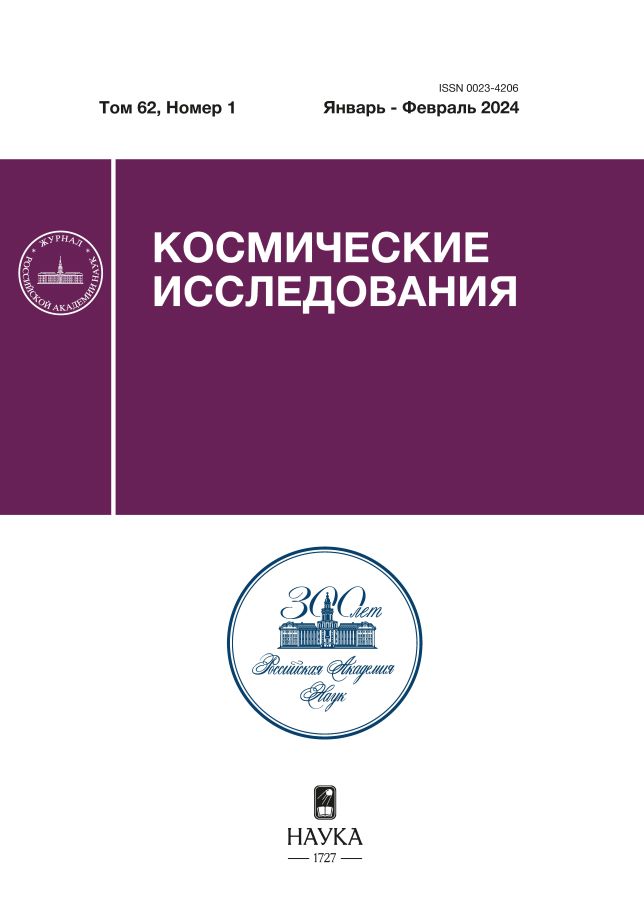Вспышки молний в облачном слое Венеры обнаружены в ближнем инфракрасном диапазоне
- Авторы: Ксанфомалити Л.В.1
-
Учреждения:
- Институт космических исследований РАН
- Выпуск: Том 62, № 1 (2024)
- Страницы: 55-68
- Раздел: Статьи
- URL: https://kld-journal.fedlab.ru/0023-4206/article/view/672499
- ID: 672499
Цитировать
Полный текст
Аннотация
Венера была первой среди планет Солнечной системы, в атмосфере которой были обнаружены электрические явления, подобные молниям в атмосфере Земли. Электрические разряды (молнии в атмосфере Венеры) были открыты в 1978 г. в миссиях «Венера-12, -11» и Pioneer Venus по их электромагнитному излучению. Парадокс, однако, заключался в том, что поиски оптических вспышек оставались безуспешными в течение сорока последующих лет. В 2015 г. на орбиту спутника Венеры был выведен аппарат AKATSUKI японского космического агентства JAXA. Он был предназначен для поиска молний и других исследований метеорологии Венеры путем регистрации излучения в выбранных спектральных диапазонах. В 2016 г. орбитальный аппарат AKATSUKI успешно выполнил подробные наблюдения Венеры в ближнем ИК-диапазоне в «окнах прозрачности» атмосферы планеты, а также в ультрафиолетовом и других диапазонах. В статье приводятся результаты альтернативного поиска и успешного обнаружения вспышек молний по данным проекта AKATSUKI, но не в ультрафиолетовом и не в видимом, а в ближнем ИК-диапазоне. Сопоставление результатов расчета, основанного на моделях земных молний, с результатами измерений, выполненных камерой IR2 миссии AKATSUKI на Венере на волне 2.26 мкм, показывает близкое совпадение экспериментальных и расчетных данных.
Полный текст
Об авторах
Л. В. Ксанфомалити
Институт космических исследований РАН
Автор, ответственный за переписку.
Email: kos.is@cosmos.ru
Россия, Москва
Список литературы
- Ксанфомалити Л. В. Молнии в облачном слое Венеры // Космич. исслед. 1979. Т. 17. № 5. С. 747–762.
- Ksanfomality L. V. Discovery of frequent lightning discharges in clouds on Venus // Nature. 1980. V. 284. P. 244–246.
- Scarf F. L., Taylor W. W., Russell C. T. et al. Lightning on Venus: Orbiter detection of whistler signals // J. Geophysical Research. 1980. V. 85. P. 8158–8166.
- Ksanfomality L. V., Scarf F. L., Taylor W. W.L. The electrical activity of the atmosphere of Venus; in “Venus”. Eds. by Hunten D. M. et al. University of Arizona Press, 1983. Tucson. Arizona. USA. P. 565–603.
- Scarf F. L., Russell C. T. Lightning measurements from the Pioneer Venus Orbiter // Geophysical Research Letters. 1983. V. 10. P. 1192–1195.
- Borucki W. J. Comparison of Venusian lightning observations // Icarus. 1982. V. 52. P. 354–364.
- Williams M. A., Thomason L. W. Optical signature of Venusian lightnings as seen from space // Icarus. 1983. V. 55. P. 185–186.
- Croft T. A., Price G. H. Evidence for a low altitude origin of lightning on Venus // Icarus. 1983. V. 53. P. 548–551.
- Lorenz R. D. Lightning detection on Venus: a critical review // Progress in Earth and Planetary Science. 2018. Iss. 5. Art.ID. 34. https://doi.org/10.1186/s40645-018-0181-x
- Takahashi Y., Yoshida J., Yair Y. et al. Lightning detection by LAC onboard the Japanese Venus climate orbiter, Planet-C // Space Science Reviews. 2008. V. 137. P. 317–334. https://doi.org/10.1007/s11214-008-9400-x
- Ксанфомалити Л. В. Низкочастотное электромагнитное поле в атмосфере Венеры по данным ВЕНЕРЫ-13 и -14 // Письма в Астрономический журнал. 1982. Т. 8. С. 424–428.
- Ксанфомалити Л. В. Планета Венера. М.: Наука ФИЗМАТЛИТ, 1985. 376 с.
- Piccioni G., Drossart P., Suetta E. et al. VIRTIS: The Visible and Infrared Thermal Imaging Spectrometer // ESA Spec. Publ. 2007. SP 1295. P. 1–27.
- Kashimura H., Sugimoto N., Takagi M. et al. Planetary-scale streak structure reproduced in high-resolution simulations of the Venus atmosphere with a low-stability layer // Nature communications. 2019. Iss. 10. Art.ID. 23. https://doi.org/10.1038/s41467-018-07919-y
- Krider E. P., Dawson G. A., Uman M. A. Peak power and energy dissipation in a single-stroke lightning flash // J. Geophysical Research. 1968. V. 73. Iss. 10. P. 3335–3339.
- Uman M. All about lightning. N.Y.: Dover Publications, 1987. 192 p.
- Vijayaraghavan G., Brown M., Barnes M. Practical grounding, bonding, shielding, and surge protection. Amsterdam; London: Elsevier, Science & Technology, 2004. P. 237.
- Кузнецов М., Кунгуров Д., Матвеев М. и др. Входные цепи устройств РЭА. Проблемы защиты от мощных импульсных перенапряжений // Новости электротехники. 2006. № 6 (42) С. 2–6.
- Ksanfomality L. V. The surface of Mercury in the 210– 350° W longitude range // Icarus. 2009. V. 200. P. 367–373. https://doi.org/10.1016/j.icarus.2008.12.007
- Ксанфомалити Л. В., Джапиашвили В. П., Кахиани В. О. и др. Опыт получения изображений Меркурия методом коротких экспозиций // Астрономич. вестник. 2001. Т. 35. № 3. С. 208–213.
- Ксанфомалити Л. В. Косвенные свидетельства проявления вулканизма на Венере // Астрономич. вестник. 1984. Т. 18. С. 310–320.
- Esposito L. W. Sulfur dioxide: Episodic injections shows evidence for active Venus volcanism // Science. 1984. 223. 1072–1074.
- Селиванов А. С., Гектин Ю. М., Герасимов М. А. и др. Продолжение телевизионного исследования поверхности Венеры со спускаемых аппаратов // Космич. исслед. 1983. Т. 21. № 2. С. 176–182. (Cosmic Research. P. 122)
Дополнительные файлы






















